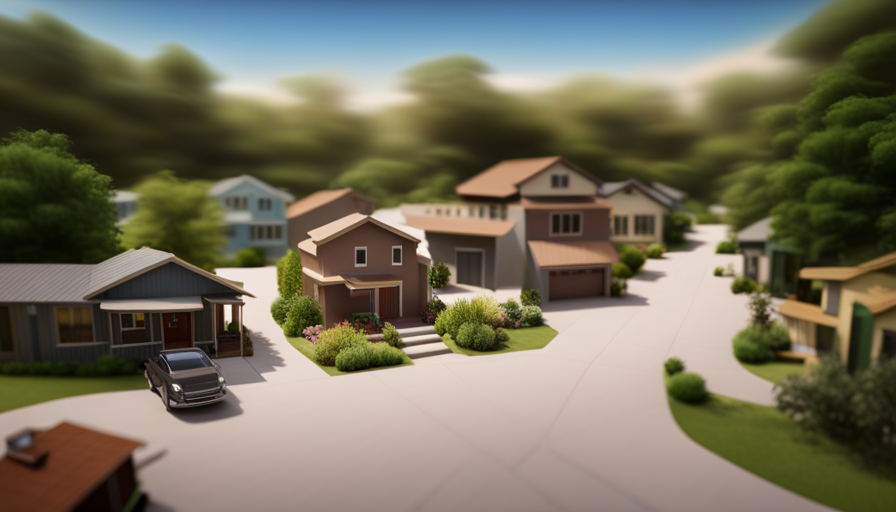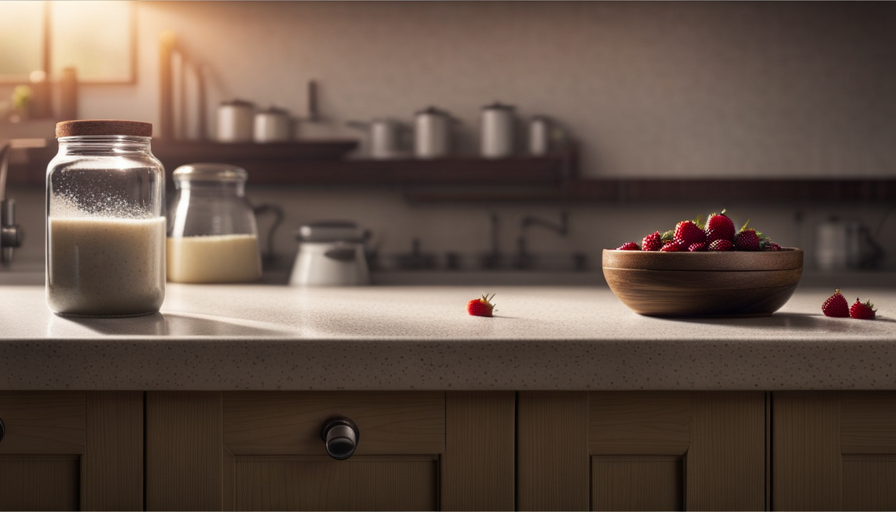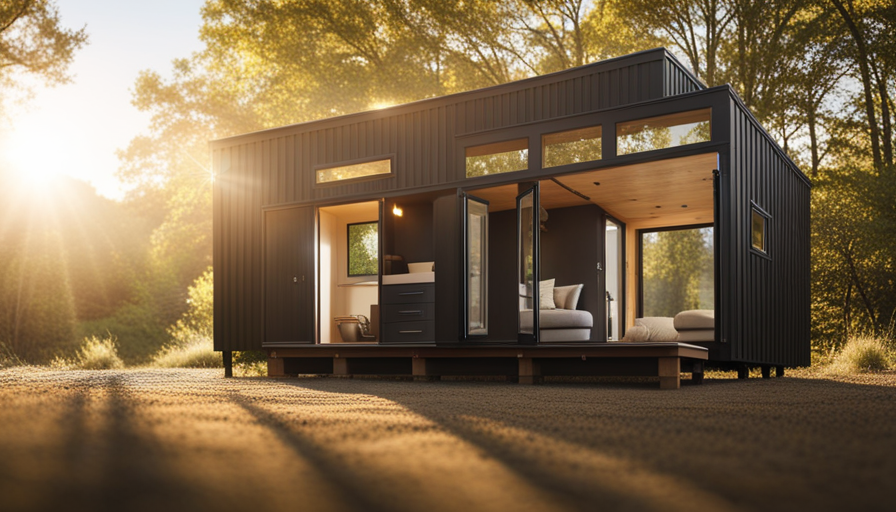Did you know that the market for tiny houses is booming? Recent data indicates that the tiny house movement has experienced significant growth in recent years. In fact, since 2018, the market for these small, practical homes has expanded by an impressive 67%.
As someone who is fascinated by housing trends and market dynamics, I decided to delve deeper into this phenomenon and explore just how big the tiny house market really is.
In this article, we will take an objective and data-driven look at the tiny house market, examining its size, growth potential, and emerging trends. We will explore the advantages and challenges of living in a tiny house, as well as the sustainable and eco-friendly benefits they offer.
Additionally, we will discuss the different types and styles of tiny houses and provide resources and support for those interested in joining this unique housing movement.
So, if you’re curious about the tiny house market and its potential for future expansion, join me as we dive into this fascinating topic.
Key Takeaways
- The tiny house market has experienced significant growth, with a 67% increase since 2018.
- The popularity of tiny houses is driven by factors such as rising housing costs, environmental concerns, and a desire for a simpler lifestyle.
- Living in a tiny house offers financial benefits, including lower construction, maintenance, and utility costs.
- Tiny houses have a reduced environmental impact compared to traditional homes, with lower energy consumption and the ability to incorporate eco-friendly practices.
Overview of the Tiny House Movement
So, how exactly did this whole tiny house thing start anyways? The tiny house movement, which has been gaining momentum in recent years, can be traced back to the early 2000s. It emerged as a response to the increasing cost of housing, environmental concerns, and a desire for a simpler, more sustainable lifestyle. The impact of the tiny house movement has been significant, as it has challenged traditional notions of homeownership and sparked a shift towards smaller, more efficient living spaces.
One of the key aspects of the tiny house movement is community building. Tiny house enthusiasts often come together to share ideas, resources, and support. Tiny house communities have sprung up across the country, providing a sense of belonging and a supportive network for those who choose to live in tiny homes. These communities often prioritize sustainable living practices, creating a culture of environmental consciousness and shared values.
The growth and popularity of tiny houses can be attributed to several factors. Firstly, the financial benefits of living in a tiny house are undeniable. With lower costs for construction, maintenance, and utilities, tiny houses offer an affordable housing solution for many. Additionally, the minimalist lifestyle promoted by the tiny house movement appeals to those seeking a simpler, clutter-free existence. The growing interest in sustainable living and the desire to reduce one’s carbon footprint have also contributed to the rise in popularity of tiny houses.
Transitioning into the subsequent section about the growth and popularity of tiny houses, it is clear that the tiny house movement has had a significant impact on the housing market and has garnered widespread attention and interest.
Growth and Popularity of Tiny Houses
With the rising demand for compact, space-efficient dwellings, it’s remarkable how the trend of downsizing and embracing minimalistic living has captured the imagination of countless individuals. The growth opportunities in the tiny house market are substantial, fueled by the increasing desire for affordable housing and sustainable living.
Here are three key factors that contribute to the popularity and expansion of the tiny house movement:
-
Market demand: As people seek more affordable housing options, tiny houses offer an attractive solution. These small homes come at a fraction of the cost of traditional houses, allowing individuals to own a home without incurring significant debt. Additionally, the rising concern for environmental sustainability has further boosted the demand for tiny houses, as they consume fewer resources and require less energy to maintain.
-
Financial advantages: The financial benefits of living in a tiny house are undeniable. With lower mortgage payments, reduced utility bills, and minimal maintenance costs, individuals can save a significant amount of money. This financial freedom provides opportunities for people to pursue their passions, travel, or invest in other areas of their lives.
-
Flexibility and mobility: Tiny houses offer a level of flexibility and mobility that traditional houses cannot match. These compact dwellings are easily transportable, allowing owners to move to different locations without the hassle of selling or renting out their property. This flexibility opens up new possibilities for individuals who desire a change of scenery or prefer a nomadic lifestyle.
As we explore the advantages of living in a tiny house, it becomes clear that this housing trend offers a unique set of benefits for those seeking a simpler and more sustainable way of life.
Advantages of Living in a Tiny House
Imagine waking up in a charming, compact dwelling nestled amidst nature, where your surroundings are serene and your daily living expenses are significantly reduced. This is just one of the many advantages of living in a tiny house. The tiny house movement has gained immense popularity in recent years, and for good reason. People are recognizing the benefits of downsizing and embracing a simpler lifestyle.
Living in a tiny house offers a multitude of advantages. Firstly, it allows for financial freedom. With a smaller space, the cost of purchasing or building a tiny house is significantly lower than that of a traditional home. Additionally, the reduced size means lower maintenance and utility costs. Imagine the savings you could enjoy without a hefty mortgage or exorbitant utility bills.
Furthermore, living in a tiny house promotes a more sustainable lifestyle. These compact homes require fewer resources to build and operate, making them environmentally friendly. Many tiny house owners incorporate eco-friendly practices such as solar power and composting toilets, further reducing their carbon footprint.
Lastly, tiny houses offer the freedom to live a more mobile lifestyle. With their small size, they can be easily transported to different locations, allowing residents to experience new environments and communities.
Transitioning to the subsequent section about challenges and considerations of tiny house living, it is important to acknowledge that while there are numerous advantages to living in a tiny house, there are also some challenges that need to be taken into account.
Challenges and Considerations of Tiny House Living
Living in a compact abode may come with a few hurdles and factors to consider. While the idea of downsizing and simplifying can be appealing, there are challenges that accompany tiny house living.
One of the main considerations is space. With limited square footage, it can be a challenge to find storage solutions and maintain a clutter-free environment. Additionally, the lack of privacy can be a concern, as most tiny houses have an open floor plan without separate rooms. Noise can easily travel throughout the space, making it difficult to find quiet moments.
Another challenge is zoning and regulations. Many areas have specific regulations regarding the size and location of dwellings, which can make it difficult to find a suitable place to park or build a tiny house. Additionally, some municipalities have minimum size requirements for residences, which may not align with the tiny house movement.
On the other hand, there are considerations that make tiny house living appealing. The lower cost of living and reduced environmental impact are significant factors for many. Tiny houses are often more affordable than traditional homes, allowing homeowners to save money on mortgage payments and utility bills. Furthermore, the smaller size of these homes means less energy is required for heating and cooling, reducing their carbon footprint.
Transitioning into the subsequent section about the ‘sustainable and eco-friendly benefits of tiny houses’, it is clear that while there are challenges and considerations to take into account, the potential for a more sustainable and eco-friendly lifestyle is a significant draw for many individuals in the tiny house market.
Sustainable and Eco-Friendly Benefits of Tiny Houses
The sustainable and eco-friendly advantages of tiny houses are truly captivating. These small dwellings have a significantly lower environmental impact compared to traditional homes. One of the key aspects of sustainability in tiny houses is their size. With less square footage to heat, cool, and maintain, they consume fewer resources and energy.
Additionally, tiny houses often incorporate energy-efficient appliances and systems, further reducing their environmental footprint. Many tiny houses also use renewable energy sources, such as solar panels, to power their electrical needs. These sustainable features not only help minimize carbon emissions but also contribute to a more eco-friendly lifestyle.
Furthermore, tiny houses promote a more sustainable use of materials. Due to their smaller size, they require fewer building materials during construction. This not only reduces waste but also encourages the use of environmentally friendly materials, such as reclaimed wood or recycled materials. Moreover, the compact design of tiny houses often encourages a minimalist lifestyle, leading to less consumption and waste generation.
Tiny houses offer numerous sustainable and eco-friendly benefits. From their reduced energy consumption to their promotion of sustainable materials and minimalist living, these small dwellings contribute to a more environmentally conscious way of life.
Transitioning into the subsequent section about the cost and affordability of tiny houses, it is important to consider the financial aspect alongside their sustainable advantages.
Cost and Affordability of Tiny Houses
If you’re considering downsizing to a tiny house, you’ll be pleased to know that they can be a much more affordable housing option, with the average cost of a tiny house being only a fraction of the price of a traditional home. This cost analysis is a major factor that attracts many people to the tiny house movement.
Here are a few financial implications to consider when it comes to tiny houses:
-
Lower upfront costs: Tiny houses generally have much lower upfront costs compared to traditional homes. The cost of purchasing or building a tiny house can vary depending on factors such as size, location, and materials used, but it is often significantly less than a conventional home.
-
Reduced ongoing expenses: Tiny houses are designed to be energy-efficient, which can lead to lower utility bills. With smaller living spaces, heating and cooling costs are reduced, and you may also save money on maintenance and repairs.
In addition to these financial benefits, living in a tiny house can also provide a simpler lifestyle with fewer material possessions and a smaller environmental footprint.
Now, let’s explore the different types and styles of tiny houses.
Different Types and Styles of Tiny Houses
Embrace the charm and creativity of diverse tiny house designs that cater to every individual’s unique lifestyle. The tiny house market offers a wide range of options when it comes to different types and styles of tiny houses.
From traditional cottages to modern minimalist designs, there is something to suit every taste and preference. These tiny homes come in various shapes and sizes, including tiny houses on wheels, container homes, and even treehouses.
When it comes to interior design, tiny houses are all about maximizing space and functionality. Clever storage solutions, multi-purpose furniture, and open floor plans are common features in tiny homes. Designers focus on utilizing every inch of space effectively, ensuring that even the smallest of homes can offer comfort and convenience.
Moreover, the interior design choices are limitless. Some tiny houses have a rustic and cozy feel with wooden accents and warm colors, while others embrace a sleek and modern aesthetic with clean lines and minimalist decor. The customization options are endless, allowing homeowners to personalize their tiny homes to reflect their own style and personality.
As we explore the different types and styles of tiny houses, it is evident that the tiny house market is constantly evolving to meet the diverse needs and preferences of individuals. From innovative designs to unique interior choices, the tiny house movement continues to push the boundaries of what’s possible in a small space.
This sets the stage for emerging trends in the tiny house market, which we’ll delve into in the subsequent section.
Emerging Trends in the Tiny House Market
One exciting trend in the evolving world of tiny homes is the incorporation of smart technology, providing homeowners with innovative ways to control and optimize their living spaces. This emerging trend is driven by market analysis and the increasing demand for convenience, efficiency, and sustainability.
-
Smart home automation: Tiny houses are now equipped with state-of-the-art technology that allows homeowners to control various aspects of their living spaces through voice commands or smartphone apps. From adjusting lighting and temperature to monitoring energy usage, smart home automation provides convenience and energy efficiency.
-
Multi-functional furniture: Another emerging trend in the tiny house market is the use of multi-functional furniture. With limited space, homeowners are opting for furniture pieces that serve multiple purposes. For example, a sofa that can be transformed into a bed or a dining table that can be folded and stored when not in use. This trend maximizes space utilization without compromising on functionality.
These trends in the tiny house market indicate a growing interest in incorporating advanced technology and maximizing space efficiency. As the market continues to evolve, it’s crucial to analyze these emerging trends to understand the potential for future expansion and market outlook.
Potential for Future Expansion and Market Outlook
The future holds immense potential for the expansion and outlook of the evolving world of compact dwellings, with innovative trends shaping the way homes are designed and integrated with cutting-edge technology.
The tiny house market has experienced significant growth in recent years, driven by a combination of factors such as affordability, sustainability, and the desire for a simpler lifestyle. As more people become aware of the benefits of tiny homes, the market is expected to continue its upward trajectory.
According to a report by Market Research Future, the global tiny house market is projected to grow at a CAGR of 5.7% from 2021 to 2026. This growth can be attributed to several factors, including the increasing demand for affordable housing solutions, the rising popularity of minimalistic living, and the flexibility that tiny homes offer in terms of mobility and customization. Additionally, advancements in technology are expected to further fuel the growth of the market, with innovations such as smart home systems and sustainable energy solutions becoming more prevalent in tiny house designs.
The future market potential for tiny houses is promising, with industry growth projected in the coming years. As more people embrace the concept of living in smaller, more sustainable spaces, the demand for tiny homes is expected to increase. This trend presents opportunities for both builders and consumers, with a wide range of resources and support available for those interested in joining the tiny house movement.
Resources and Support for Those Interested in Tiny Houses
If you’re interested in exploring the world of compact dwellings, there are plenty of resources and support available to help you navigate this exciting journey. The tiny house movement has gained significant momentum in recent years, and as a result, there is a wealth of information and assistance for those looking to join in on the trend. Here are three key resources and support systems that can help you on your tiny house adventure:
-
Online Communities: There are numerous online forums and social media groups dedicated to tiny house enthusiasts. These platforms provide a space for like-minded individuals to share ideas, ask questions, and offer guidance. Connecting with others who’ve already built or are in the process of building their own tiny homes can be invaluable.
-
Workshops and Courses: Many organizations and individuals offer workshops and courses specifically tailored to tiny house construction and design. These educational opportunities provide hands-on experience, expert advice, and the chance to network with others in the industry. Whether you’re a beginner or have some building experience, these resources can help you gain the skills and knowledge needed to successfully create your own tiny home.
-
Tiny House Builders and Consultants: If you prefer a more hands-off approach, there are professionals who specialize in building and consulting on tiny houses. These experts can assist with everything from design and planning to construction and customization. Hiring a professional can save you time and stress while ensuring your tiny house meets all necessary codes and regulations.
With these resources and support systems at your disposal, you can confidently embark on your tiny house journey and make your compact dwelling dreams a reality.
Frequently Asked Questions
What are the building regulations for tiny houses in different countries?
Building regulations for tiny houses vary across different countries. While some countries may have specific building codes and zoning restrictions in place for tiny houses, others may not have clear guidelines. However, it’s important to note that building codes and zoning restrictions are generally more relaxed for tiny houses compared to traditional homes. This flexibility allows for innovative and creative designs while ensuring basic safety standards are met.
Are there any restrictions on where you can park or place a tiny house?
Parking regulations and zoning restrictions play a crucial role in determining where one can park or place a tiny house. These regulations vary by jurisdiction and can limit the areas where tiny houses are allowed.
Some cities have specific zoning laws that classify tiny houses as either RVs or accessory dwelling units, allowing them to be parked in certain areas. However, many areas have restrictions on parking tiny houses on public streets or in residential areas due to size limitations or aesthetic considerations.
How do tiny house owners deal with limited storage space?
Like a master puzzle solver, tiny house owners skillfully navigate the challenge of limited storage space, maximizing every nook and cranny. They ingeniously employ creative storage solutions to make the most of their compact living quarters.
From built-in shelving to multi-functional furniture, every inch is meticulously utilized. By thinking outside the box, these resourceful individuals create a harmonious balance between functionality and aesthetics, proving that size is no barrier to efficient and stylish living.
Can you finance a tiny house like a traditional home?
Yes, financing options are available for tiny houses similar to traditional homes. However, loan requirements for tiny houses may differ from those of larger homes. Lenders may consider factors like the size and value of the tiny house, the borrower’s credit history, and the ability to repay the loan.
It’s important to research and compare different lenders to find the best financing option for your specific tiny house project.
What are the insurance requirements for a tiny house?
Insurance coverage for a tiny house varies based on its size, location, and intended use. Legal considerations come into play as well, as some jurisdictions require certain types of insurance for tiny houses. Generally, insurance coverage for a tiny house includes property coverage for the structure and personal belongings, liability coverage in case of accidents or injuries, and possibly coverage for towing and theft. It’s important to consult with an insurance provider to ensure adequate coverage for your specific tiny house.
Conclusion
In conclusion, the tiny house market is no longer a small niche, but a thriving industry that continues to grow. Just like a tiny house itself, this market has proven to be resilient and adaptable, offering a sustainable and affordable housing solution for many.
As the movement gains momentum, it’s important to consider the challenges and benefits of tiny house living, and to stay informed about emerging trends and resources.
With the potential for future expansion, the tiny house market is poised to make a big impact on the housing industry.
Hi, I’m Emma. I’m the Editor in Chief of Tiny House 43, a blog all about tiny houses. While tree houses are often associated with childhood, they can be the perfect adult retreat. They offer a cozy space to relax and unwind, surrounded by nature. And since they’re typically built on stilts or raised platforms, they offer stunning views that traditional homes simply can’t match. If you’re looking for a unique and romantic getaway, a tree house tiny house might just be the perfect option.










